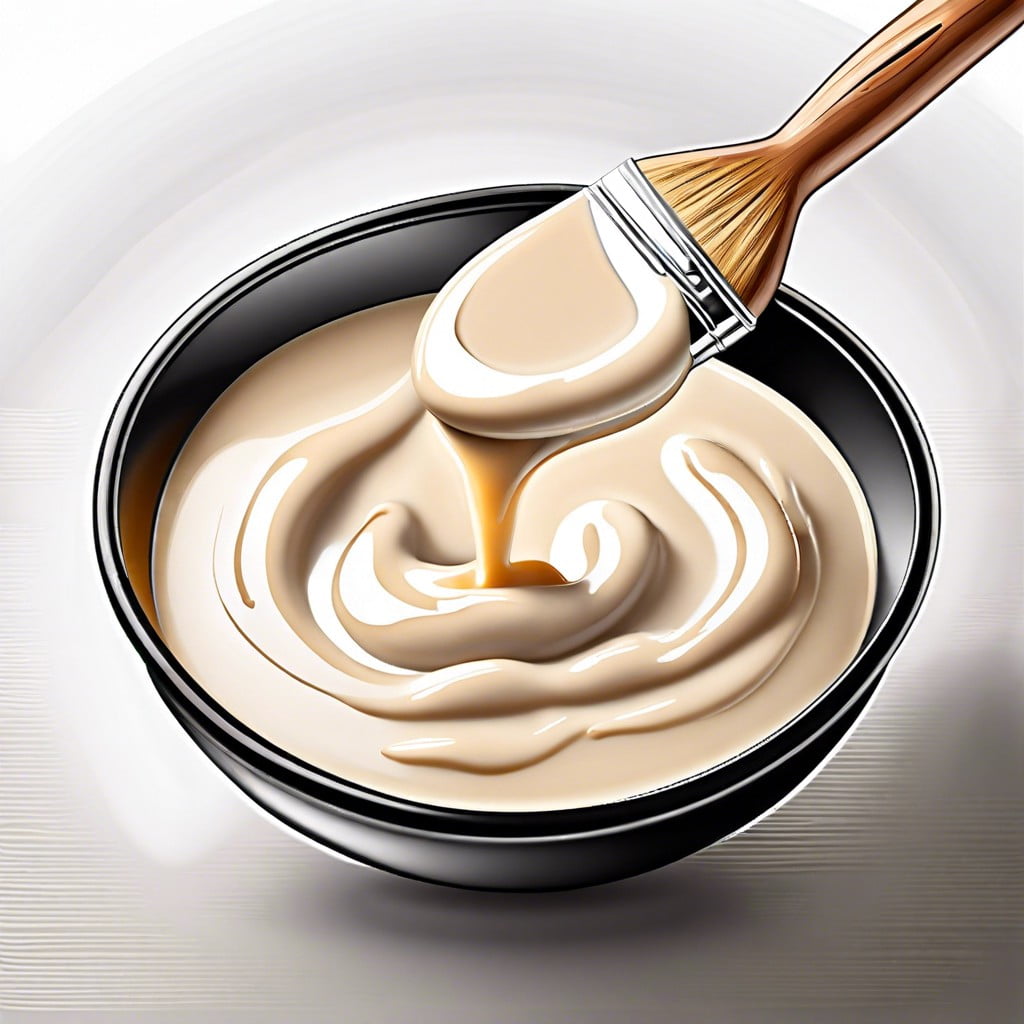Unveiling the unique profile of white BBQ sauce, this article sheds light on its origins, flavor nuances, and versatile applications in Southern cuisine.
Key takeaways:
- White BBQ sauce is a tangy, mayonnaise-based condiment from Alabama.
- Key ingredients include mayonnaise, vinegar, horseradish, and lemon juice.
- To make white BBQ sauce, whisk together the ingredients and refrigerate.
- Serve white BBQ sauce with chicken, turkey, pork, vegetables, and more.
- Follow a lower and slower grilling method for bone-in chicken breasts.
What Is White BBQ Sauce?

Originating from Northern Alabama, this tangy, mayonnaise-based condiment defies the traditional BBQ sauce archetype. Distinctive for its ivory hue, it’s a departure from the common red, tomato-based varieties.
The sauce’s creamy texture and unique blend of flavors, including vinegar and often horseradish or mustard, bring a refreshing twist to the smoky profiles of grilled meats.
It’s not just a regional novelty; its versatility has garnered a following far beyond its Southern roots, offering a zesty alternative to the classic BBQ sauce palate.
Alabama White BBQ Sauce Ingredients
Alabama white BBQ sauce principally hinges on mayonnaise, lending it a creamy base that distinguishes it from tomato-based counterparts.
To balance the richness, apple cider vinegar is included, providing a tangy note.
The addition of horseradish injects a piquant zest, ensuring the sauce carries a subtle heat.
Rounding out the flavor profile, lemon juice imparts a citrus freshness, while black pepper and additional seasonings like garlic powder and salt contribute depth and complexity to the sauce.
Mustard, often prepared, adds an extra layer of tanginess and spice, harmoniously melding with the other ingredients.
These components, once whisked together, create a versatile sauce with a smooth consistency ideal for a range of barbecue dishes.
How to Make Alabama White BBQ Sauce – the Recipe Steps
Begin by gathering the essential components: mayonnaise, vinegar (typically apple cider for its tangy depth), lemon juice for a citrusy zing, and the spices – garlic powder, onion powder, pepper, and salt to taste. Some may choose to incorporate a hint of sugar for balance.
2. Whisk together the mayonnaise and vinegar in a mixing bowl until you achieve a smooth, well-blended base. This step ensures that the tangy flavor is evenly distributed throughout the sauce.
3. Squeeze in fresh lemon juice, a crucial element that not only brightens the flavor profile but also adds a subtle complexity.
4. Incorporate the spices one by one, stirring continuously to prevent clumping and guarantee a uniform mixture.
5. Fine-tune the seasoning. Taste your concoction after each spice addition to ensure the flavors meld correctly and adjust as necessary.
6. Let the sauce rest. Cover and refrigerate for at least an hour, allowing the ingredients to coalesce and the flavors to intensify.
7. Prior to serving, give the sauce a final stir to refresh the smooth consistency and ensure a homogenous blend.
Serving Suggestions for White BBQ Sauce
This versatile sauce is traditionally paired with barbecued chicken, but its unique tangy profile can enhance a multitude of dishes. Consider slathering it over smoked turkey or pork chops to add a creamy, acidic balance that cuts through the richness.
It’s also excellent as a dip for crispy fried or grilled vegetables, offering a delightful contrast to their natural sweetness. Don’t hesitate to drizzle it over a loaded baked potato or stir a spoonful into coleslaw for an unexpected twist.
For an all-American experience, use it as a dressing for pulled pork sandwiches, creating a symphony of flavors that dance on the palate. Remember, the sauce’s robust character can lift even the simplest of snacks, such as potato chips, into a gourmet treat.
How to Grill Bone-in Chicken Breasts
Bone-in chicken breasts require a lower and slower approach to grilling. Heat your grill to a medium temperature, creating a zone for indirect heat. Start by placing the chicken skin-side down over direct heat for a short sear—roughly 5 minutes—to achieve a crispy exterior. Then, transfer it to the cooler, indirect heat zone.
Close the grill lid to maintain a consistent cooking environment. This mimics the effect of an oven, ensuring that the meat near the bone cooks through without burning the outside. Use a meat thermometer to check for doneness, looking for an internal temperature of 165°F, which will take about 30-40 minutes depending on size and thickness.
During the last few minutes of cooking, baste the chicken with white BBQ sauce, allowing it just enough time on the heat to adhere to the chicken and generate a flavorful layer. Remove from the grill and let it rest for five minutes before serving. This resting period is crucial as it allows the juices, which have been driven to the center of the breast by the heat, to redistribute, ensuring the meat is juicy and succulent throughout.

